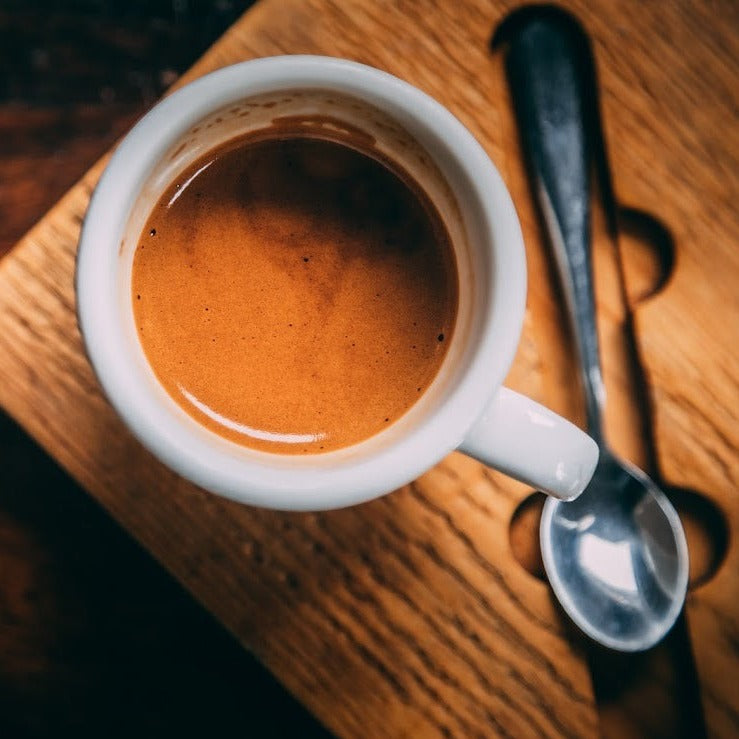Discovering the Origins Behind Specialty SOE Single Origin Espresso
Discovering the Origins Behind Specialty SOE Single Origin Espresso
Blog Article
Checking Out the Rich Flavors of Coffee Beans: a Deep Study Coffee and Blended Coffee Beans
When you check out the rich flavors of coffee beans, you uncover an intricate globe where each range brings its own personality to your mug. Recognizing the beginnings, processing methods, and toasting strategies can change your coffee experience. As you navigate through the art of espresso and the creativity behind combined coffees, you'll start to appreciate the subtleties that make each sip unique. What you'll discover next might change the means you appreciate your early morning mixture.
The Origins of Coffee Beans: Discovering Terroir and Flavor Profiles
When you take a sip of coffee, you're not simply enjoying a beverage; you're experiencing a rich tapestry of flavors formed by the beans' origins. Each region generates distinct taste accounts influenced by climate, dirt, and altitude. Beans from Ethiopia commonly burst with intense, fruity notes, while those from Colombia tend to use a balanced, nutty sweetness.
As you discover different beginnings, you'll notice exactly how terroir-- the environmental elements influencing a crop-- plays an essential function - Single Origin Espresso. The very same coffee range can taste substantially different depending on where it's expanded
When you think about these variables, you start to appreciate the intricacy behind your cup. Each sip tells a tale of the land and the farmers who nurtured the beans. So, following time you indulge, think regarding the journey your coffee took before it reached your hands, and savor those intricate flavors that reflect its beginning.
Understanding Coffee: The Art and Science Behind the Brew
When you think of espresso, it's not practically the solid taste; it's likewise concerning the methods that bring it to life. Recognizing how different prep work techniques effect taste can transform your brewing experience. Let's check out the intricacies of espresso preparation and discover the one-of-a-kind taste accounts that make each cup special.
Espresso Prep Work Methods
Espresso prep work is both an art and a scientific research, integrating accurate techniques with a deep understanding of coffee. To begin, you'll wish to select high-quality, fresh baked beans and grind them carefully for suitable removal (Single Origin Espresso). The work size is important; too coarse, and your coffee will certainly be weak, as well great, and it'll be bitter
The result must be a rich, luscious espresso with an attractive layer of crema on top. With method, you'll master these methods.
Flavor Accounts Discussed
The globe of espresso supplies an abundant tapestry of flavor profiles that can boost your coffee experience. When you take that first sip, you'll observe a balance of sweetness, resentment, and level of acidity. Each coffee bean brings unique notes, from flower and fruity to nutty and chocolaty. Light roasts usually display intense level of acidity and vivid tastes, while dark roasts existing deeper, bolder tones.
Comprehending these profiles helps you choose the right espresso for your palate. Trying out different blends can reveal unexpected combinations. A well-crafted mix could harmonize the bright notes of an Ethiopian bean with the rich, chocolatey undertones of a Brazilian bean. Accept the journey of finding coffee's varied flavors, and you'll transform your coffee ritual right into an amazing journey.
Processing Methods: Just How They Impact Flavor and Aroma
While it could appear that the origin of coffee beans is the most significant consider establishing their flavor and aroma, the handling techniques used post-harvest play an equally important role. You'll locate that these techniques can substantially change the final preference profile of your cup.
As an example, the washed procedure eliminates the fruit from the beans before fermentation, often leading to a cleaner, brighter taste. The natural process leaves the fruit intact during drying out, resulting in a sweeter, fruitier account.
Other methods, like honey handling, strike an equilibrium, enabling some fruit mucilage to stay, supplying a distinct complexity.
Each processing method connects with the beans' inherent features, improving or muting details tastes and aromas. When you sip that espresso or mixed coffee, keep in mind that the trip from cherry to cup is affected not simply by origin yet likewise by how those beans were refined.
Roasting Strategies: Unlocking the Full Prospective of Coffee Beans
Roasting strategies are vital for disclosing the complete possibility of coffee beans, as they change raw, green beans into the aromatic, delicious coffee you take pleasure in. The choice of roasting method-- light, medium, or dark-- significantly influences flavor accounts.
You can experiment with toasting temperature levels and times to discover your best mixture. A slower roast at reduced temperatures permits complex flavors to create, while a quicker roast can intensify anger. Take notice of the splits during roasting; the initial split suggests a light roast, while the second crack signals a dark roast. By understanding these strategies, you'll disclose a world of flavor, boosting your coffee experience to brand-new elevations. Delight in every sip, knowing the care that entered into your mug!
The Magic of Blended Coffee: Producing Distinct Flavor Experiences
Developing an one-of-a-kind taste experience with blended coffee can change your morning ritual into an expedition of taste. By incorporating various beans from various areas, you can expose a symphony of tastes that raise your cup to brand-new heights. Each mix deals a distinct profile, balancing sweetness, body, and level of acidity to create something absolutely unique.
When you choose a blend, you're not simply selecting a coffee; you're selecting a trip across diverse landscapes and societies. Explore various mixes enables you to uncover your personal favorites, whether you enjoy fruity notes or rich, chocolatey touches.

Tasting Notes: Identifying the Nuances in Your Cup
As you drink your coffee, you could notice a spectrum of flavors dancing on your taste, each disclosing the ins and outs of the beans. You might taste the intense level of acidity reminiscent of citrus or the deep, rich notes similar to dark delicious chocolate. The sweet taste can evoke honey or caramel, balancing the general account beautifully.
Focus on the body of the coffee-- does it learn the facts here now feel light and airy, or is it complete and luscious? The coating, too, provides hints; a remaining aftertaste might mean nuttiness or flower touches.

Don't forget to explore the unique characteristics of various beginnings, as each area presents unique flavors - Single Origin Espresso. For example, Ethiopian coffees typically present fruity notes, while Colombian beans might display an extra spherical sweetness. By identifying these Find Out More subtleties, you'll strengthen your recognition for every cup, elevating your coffee experience to new elevations

Developing Approaches: Making The Most Of Flavor Removal for every single Bean
When you discover the numerous developing techniques, you'll find that each method can dramatically affect the flavor profile of your coffee. From French press to pour-over, each approach essences different compounds, enhancing or silencing particular notes. Utilizing a French press enables oils to stay in the brew, developing a richer taste, while pour-over emphasizes quality and brightness.
Temperature and grind dimension also play vital roles. A coarser grind functions best for cold mixtures, while a great grind is excellent for espresso. Explore water temperature-- in between 195 ° F and 205 ° F-- can reveal covert tastes, too.
Don't ignore soaking time; a fast extraction can bring about sour notes, while over-extraction may produce anger. By adjusting these variables, you can maximize flavor removal and truly raise your coffee experience. Appreciate the journey of finding what approach best fits your taste!
Frequently Asked Concerns
What Is the Perfect Water Temperature Level for Brewing Coffee?
The suitable water temperature for brewing coffee's between 195 ° F and 205 ° F. If you utilize water that's also hot, you'll over-extract flavors; as well cool, and you will not extract sufficient. Goal for that pleasant place for the very best brew!
How Does Grind Dimension Affect Coffee Flavor?
Grind size considerably impacts coffee flavor. Finer grinds extract much more flavors and oils, leading to a bolder taste, while coarser grinds yield a lighter flavor. Changing grind size helps you achieve your desired coffee profile.
Are There Health Benefits Associated With Drinking Coffee?

What Is the Difference In Between Arabica and Robusta Beans?
Arabica beans are smoother and sweeter, usually including fruity tastes, while robusta beans are more powerful with a bitter preference and greater caffeine content. You'll notice these distinctions in fragrance and developing experience.
Just How Can I Shop Coffee Beans for Quality?
To save Full Report coffee beans for quality, keep them in an impermeable container, far from moisture, warmth, and light. If you only grind what you need right before developing., you'll keep their taste longer.
Discovering the Rich Flavors of Coffee Beans: a Deep Dive Into Coffee and Blended Coffee Beans.
When you check out the rich tastes of coffee beans, you discover an intricate globe where each selection brings its very own character to your cup.When you take a sip of coffee, you're not just enjoying a beverage; you're experiencing an abundant tapestry of flavors shaped by the beans' beginnings.Roasting techniques are essential for disclosing the complete capacity of coffee beans, as they transform raw, green beans right into the aromatic, delicious coffee you delight in.As you drink your coffee, you could discover a spectrum of tastes dancing on your taste, each exposing the intricacies of the beans.
Report this page